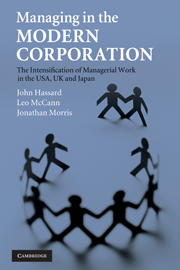Book contents
- Frontmatter
- Contents
- Acknowledgements
- About the cover
- 1 Going under the knife: Downsizing and de-layering the modern corporation
- 2 Exploring corporate life: A realist view on management restructuring
- 3 Living in the house that Jack built: Management restructuring in America
- 4 Maximising shareholder value: Management restructuring in Britain
- 5 New world of the salaryman: Management restructuring in Japan
- 6 Fighting back? Addressing the human costs of management restructuring
- Appendix
- References
- Index
3 - Living in the house that Jack built: Management restructuring in America
Published online by Cambridge University Press: 09 February 2010
- Frontmatter
- Contents
- Acknowledgements
- About the cover
- 1 Going under the knife: Downsizing and de-layering the modern corporation
- 2 Exploring corporate life: A realist view on management restructuring
- 3 Living in the house that Jack built: Management restructuring in America
- 4 Maximising shareholder value: Management restructuring in Britain
- 5 New world of the salaryman: Management restructuring in Japan
- 6 Fighting back? Addressing the human costs of management restructuring
- Appendix
- References
- Index
Summary
[S]pecific companies, especially in the late 1990s at the height of the cult, implemented copies of what they imagined Jack [Welch] did.
(Froud et al., 2006: 365)Nowhere has the discussion about the changing fortunes of large corporations had a higher profile than in the USA. America is the historical home of the Chandlerian giant firm, the birthplace of business schools, MBAs, management consulting and ‘change gurus’. It is where downsizing and business process re-engineering (BPR) first emerged, and also where the backlash against these phenomena has been most vivid, both in academic literature (such as Cascio 1993; Heckscher 1996; Smith, 1990) and popular culture (Bakan 2005; Moore 1997).
The USA and its large firms continue to be at the forefront of debates around economic shifts since the 1970s, and the more specific impact of the restructuring of capital on firms and employees. Traditional Marxist literature focuses strongly on the US model (Baran and Sweezy 1966; Braverman 1974/1998). There is a reasonably well-established concept of the core features of a giant corporation in most parts of the world, and this concept is largely modelled on the publicly listed, divisionalised, US bureaucratic firm. This idealised firm has, of course, been through significant changes. Business and labour historians such as Alfred Chandler and Sanford Jacoby have written widely on the makeup and purpose of the large firm, especially since the New Deal era, in which US firms were bureaucratic, often vertically integrated and paternalistic, with large internal hierarchies of lifetime employees and many layers of white-collar management.
- Type
- Chapter
- Information
- Managing in the Modern CorporationThe Intensification of Managerial Work in the USA, UK and Japan, pp. 55 - 123Publisher: Cambridge University PressPrint publication year: 2009



